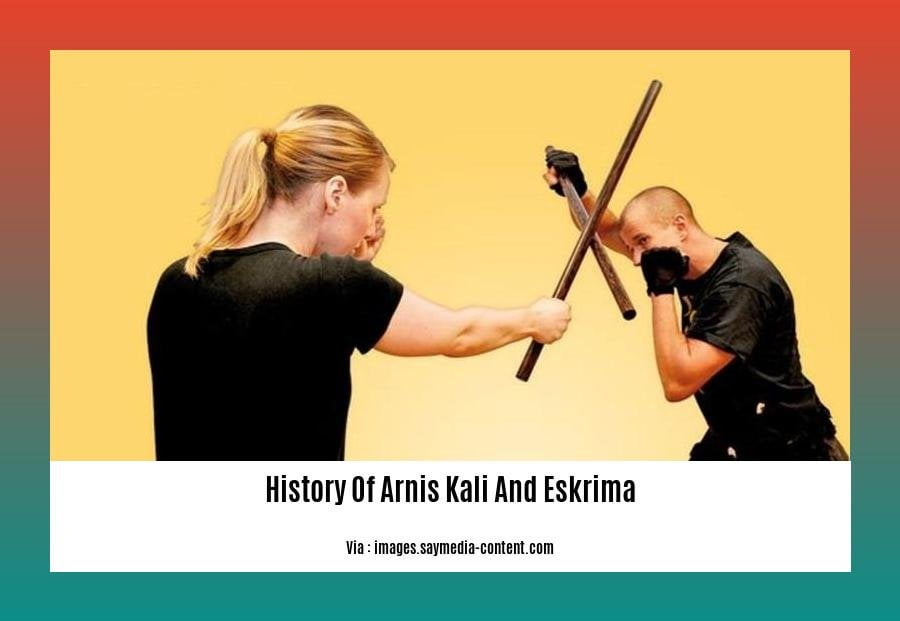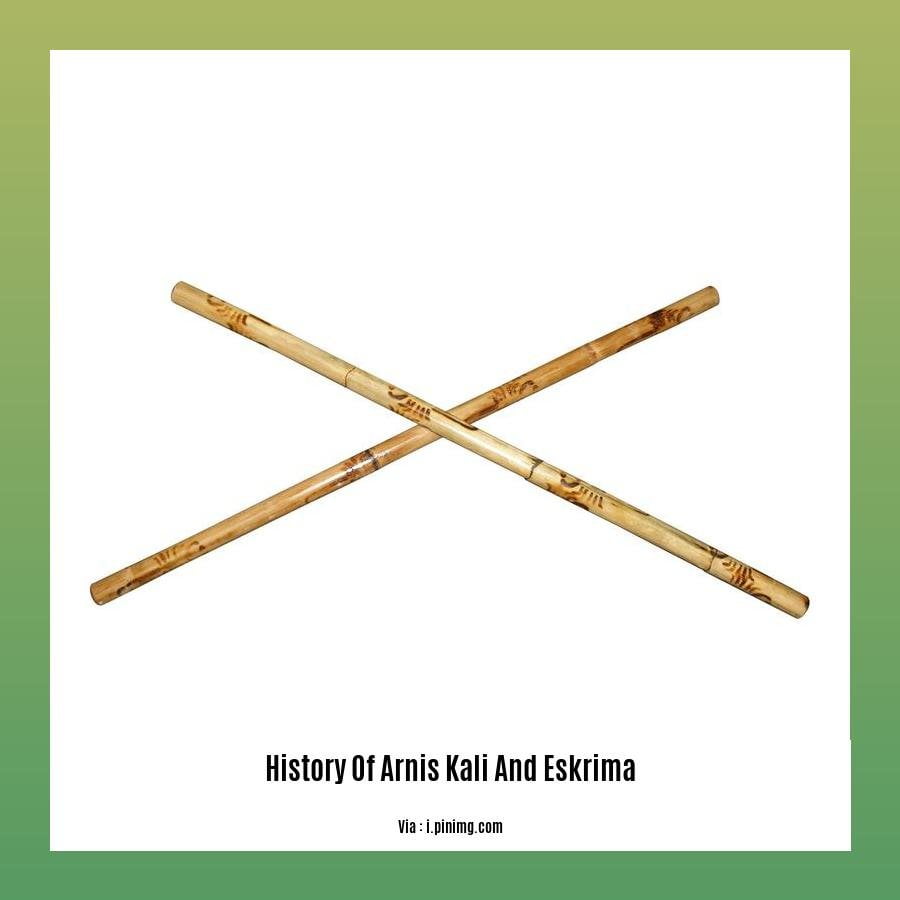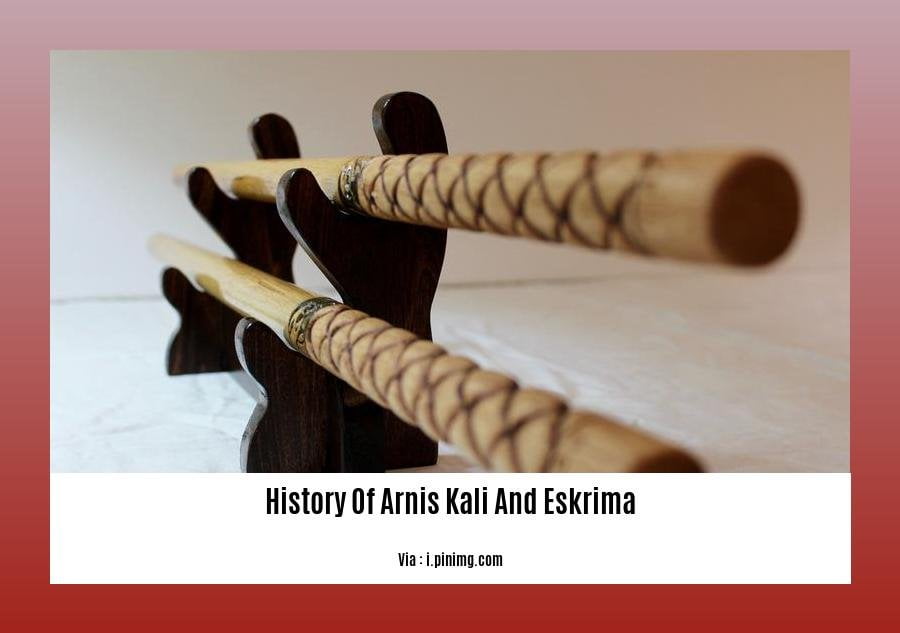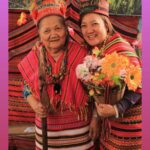– The Comprehensive History of Arnis Kali and Eskrima: Unraveling the Roots of Filipino Martial Arts –
Key Takeaways:
- Eskrima, Arnis, and Kali are terms for traditional Filipino martial arts.
- Arnis emerged in pre-colonial times for self-defense among commoners.
- The origin of Arnis is largely based on storytelling and marketing.
- Indigenous influences shaped Arnis as both a combat and self-defense system.
- Arnis was employed by Filipino guards during Spanish colonization.
- The 20th century witnessed a resurgence of Arnis with the establishment of schools and organizations.
History Of Arnis Kali and Eskrima

Eskrima, Arnis, and Kali are interchangeable terms for the traditional Filipino martial arts. Arnis refers to the stick-fighting component, Kali emphasizes knife fighting, and Eskrima encompasses both stick and knife fighting.
Origin and Development
Arnis originated in the pre-colonial Philippines as a weaponless self-defense system used by commoners. It evolved into a sophisticated martial art, incorporating weapons such as sticks, knives, and bladed weapons. Arnis was heavily influenced by indigenous traditions and was used for both warfare and self-defense.
During the Spanish colonial era, Arnis was practiced by Filipino guards, who used it to defend against Spanish weaponry. The art experienced a revival in the 20th century with the establishment of schools and organizations dedicated to preserving and promoting it.
Impact on Filipino Culture
Arnis played a significant role in Filipino culture, fostering a sense of national identity and embodying values such as bravery, skill, and self-reliance. It also influenced other aspects of Filipino life, including music, dance, and storytelling.
Different Styles
Over time, various styles of Arnis Kali and Eskrima emerged, each with its unique techniques and weapons combinations. Some notable styles include:
- Doce Pares
- Inayan Eskrima
- Modern Arnis
- Pekiti-Tirsia Kali
- Sayoc Kali
Each style reflects the influence of different regions, lineages, and instructors, contributing to the rich diversity of the art.
Conclusion
Arnis Kali and Eskrima are living testimonies to the rich martial arts heritage of the Philippines. They have survived centuries of change, evolving to adapt to different eras and situations. Today, these arts continue to be practiced and studied worldwide, promoting cultural preservation, self-defense, and physical well-being.
If you’re a martial arts enthusiast seeking to delve into the rich heritage of Filipino combat, be sure to visit our comprehensive article on the history of arnis. Alternatively, if you’re interested in the historical roots of the Arniston family estate in Midlothian, Scotland, you’ll find a wealth of information in our article on the History Of Arniston. And for those eager to explore the topic further, our article on the History Of Arnis Brainly provides a valuable resource.
Key Figures in Arnis, Kali, and Eskrima

Eskrima, Arnis, and Kali share a rich history and deep connection with the Filipino culture. Over the centuries, these martial arts have been passed down through generations, evolving and adapting along the way. At the heart of this evolution are key figures who have played a pivotal role in shaping these arts.
Eskrima, Arnis, and Kali are closely intertwined, sharing many similarities and techniques. However, there are also distinctions between the three. Let’s delve into some key figures associated with these martial arts:
Grand Master Remy Presas is widely regarded as the father of modern Arnis. He developed the Modern Arnis system, which emphasizes practical self-defense and close-quarters combat. Presas was known for his speed, agility, and innovative techniques.
Grand Master Ernesto Presas is the son of Remy Presas and continued his father’s legacy. He further developed Modern Arnis and traveled extensively to teach and promote the art. Presas is known for his contributions to the development of stick and knife fighting techniques.
Master Leo Gaje is a renowned Eskrimador known for his expertise in single and double stick techniques. He is the founder of Pekiti-Tirsia Kali, a system focused on empty-hand combat, knife fighting, and stick fighting. Gaje’s techniques are known for their simplicity and effectiveness in real-life situations.
These are just a few of the many key figures who have shaped Eskrima, Arnis, and Kali. Their contributions have helped preserve and evolve these martial arts, ensuring their continued relevance and effectiveness in both self-defense and cultural preservation.
Key Takeaways:
- Eskrima, Arnis, and Kali are closely related Filipino martial arts that emphasize weapons training.
- Key figures have played a crucial role in their development and dissemination.
- Grand Master Remy Presas, Grand Master Ernesto Presas, and Master Leo Gaje are among the most influential figures in these arts.
- Their contributions have shaped the techniques, principles, and philosophies of Eskrima, Arnis, and Kali.
Relevant Sources:
- Which Martial Arts: Eskrima / Arnis / Kali
- Filipino Martial Arts Pulse: Filipino Martial Arts History
Cultural Significance of the Martial Arts
Arnis, Kali, and Eskrima (AKE) are deeply rooted in Filipino culture and history, embodying the spirit of the nation. These martial arts are more than just combat techniques; they are a reflection of the Filipino people’s resilience, ingenuity, and cultural heritage.
Origins and Development
AKE originated in the Philippines’ pre-colonial era, serving as a practical defense system against foreign invaders. Filipinos adapted their indigenous fighting skills to resist Spanish colonizers, using everyday tools such as sticks and bladed weapons. This crucible of conflict forged the foundation of what we know as AKE today.
Cultural Symbolism
AKE is a symbol of Filipino self-reliance and nationalism. During the Philippine Revolution, AKE practitioners played a crucial role in the fight for independence, wielding their skills against the colonial powers. The martial arts became a source of pride and unity, fostering a sense of national identity.
Values and Discipline
AKE training goes beyond physical techniques; it instills important values such as courage, respect, and humility. Practitioners learn self-control, discipline, and mental fortitude, which extend beyond the training hall into their daily lives.
Cultural Preservation
AKE is an integral part of Filipino cultural heritage, passed down from generation to generation. Preserving and practicing these martial arts helps maintain cultural diversity and provides a connection to the past. Various organizations and schools work diligently to safeguard and promote AKE’s legacy.
Key Takeaways:
- AKE martial arts are deeply rooted in Filipino culture and history.
- They were originally used as a defense system against foreign invaders.
- AKE is a symbol of Filipino self-reliance and nationalism.
- AKE training instills important values such as courage, respect, and humility.
- Preserving AKE is crucial for maintaining cultural diversity.
Citations:
Arnis – Filipino Martial Arts – History and Styles
Eskrima, Arnis and Kali: A History
Modern-Day Practice of Arnis, Kali, and Eskrima
In today’s world, Arnis, Kali, and Eskrima remain vibrant and dynamic martial arts, practiced by enthusiasts around the globe. The modern-day practice of these arts is a testament to their timelessness and relevance.
Key Takeaways:
- Arnis, Kali, and Eskrima are practiced globally, blending tradition with modern training methods.
- Practitioners appreciate the self-defense skills, cultural significance, and the discipline it instills in them.
- Various training methods cater to diverse individuals, from traditional forms to sports-oriented approaches.
Modern Training Methods
- Traditional Training: Focuses on preserving the original techniques and principles, passed down through generations of masters.
- Sports-Oriented Training: Emphasizes athleticism, competition, and the development of specific skills for tournaments.
- Hybrid Training: Blends elements of both traditional and sports-oriented training, providing a comprehensive approach.
Benefits of Modern-Day Practice
- Self-Defense: Arnis, Kali, and Eskrima provide effective self-defense techniques against various threats.
- Cultural Appreciation: Practitioners connect with Filipino history and traditions through these arts.
- Discipline: The rigorous training instills discipline, respect, and mental fortitude.
- Physical Fitness: The dynamic movements and techniques enhance cardiovascular health, strength, and flexibility.
- Stress Relief: Training can be a therapeutic outlet for releasing stress and promoting relaxation.
Conclusion
The modern-day practice of Arnis, Kali, and Eskrima continues to flourish, preserving the cultural heritage while adapting to contemporary needs. Whether for self-defense, cultural enrichment, or personal growth, these martial arts offer invaluable benefits for practitioners in the 21st century.
Relevant Sources:
- Eskrima: A Comprehensive Guide to Filipino Martial Arts
- Arnis: The National Martial Art of the Philippines
FAQ
Q1: What is the historical origin of Arnis, Kali, and Eskrima?
Q2: How did Eskrima, Arnis, and Kali evolve during the Spanish colonial era?
Q3: What is the significance of the term “Kali” in relation to Filipino martial arts?
Q4: How did Arnis contribute to the Filipino resistance against colonial rule?
Q5: What are some key figures responsible for the preservation and dissemination of Arnis, Kali, and Eskrima?
- Unlock Water’s Symbolism: A Cross-Cultural Exploration - April 20, 2025
- Identify Black and White Snakes: Venomous or Harmless? - April 20, 2025
- Unlocking Potential: Origins High School’s NYC Story - April 20, 2025

![- Unraveling the History of Arnis: A Filipino Martial Art Legacy [History Of Arnis Brainly] History-Of-Arnis-Brainly_2](https://www.lolaapp.com/wp-content/uploads/2024/02/History-Of-Arnis-Brainly_2-150x150.jpg)













